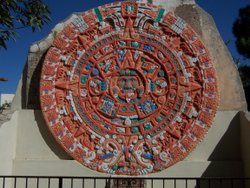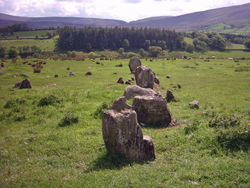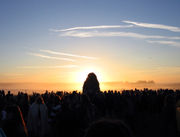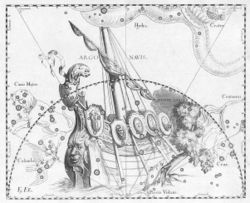Archaeoastronomy
2007 Schools Wikipedia Selection. Related subjects: Space (Astronomy)

Archaeoastronomy (also spelled Archeoastronomy) is the study of ancient or traditional astronomies in their cultural context, utilising archaeological and anthropological evidence. The anthropological study of astronomical practices in contemporary societies is often called ethnoastronomy, although there is no consensus as to whether ethnoastronomy is a separate discipline or is a part of archaeoastronomy. Archaeoastronomy is also closely associated with historical astronomy, the use of historical records of heavenly events to answer astronomical problems and the history of astronomy, which uses written records to evaluate past astronomical traditions.
It is most frequently mentioned with astronomical claims regarding Stonehenge or the pyramids of Egypt.
History of archaeoastronomy
Archaeoastronomy is almost as old as archaeology itself. Heinrich Nissen was arguably the first archaeoastronomer, publishing Das Templum: Antiquarische Untersuchungen in 1869. Other researchers followed. The astronomer Norman Lockyer was active at the end of the nineteenth century and the start of the twentieth. His studies included an examinations of Egyptian temples in The Dawn of Astronomy in 1894 and of Stonehenge published as Stonehenge and Other British Stone Monuments Astronomically Considered in 1906. The archaeologist Francis Penrose published extensively in the Philosophical Transactions of the Royal Society on the astronomical alignment of Greek temples in the Mediterranean in the same period. Archaeoastronomy was, for a while, a respectable subject. The first issue of the archaeological journal Antiquity includes an article on archaeoastronomical research.
In the British Isles interest in archaeoastronomy waned until the 1960s when the astronomer Gerald Hawkins proposed that Stonehenge was a Neolithic computer. Around the same time the engineer Alexander Thom published his survey results of megalithic sites also proposed widespread practice of accurate astronomy in the British Isles. The claims of Hawkins were largely dismissed. However, Thom's analysis continued to pose a problem. A re-evaluation of Thom's fieldwork by Clive Ruggles attempted to show that his claims of high accuracy astronomy were not fully supported by the evidence. Nevertheless there was evidence of widespread interest in astronomy associated with megalithic sites. The response from most archaeologists was tepid. Only one, Euan MacKie, recognised that Thom's theories needed to be tested and he excavated at the Kintraw standing stone site in Argyllshire in 1970 and 1971 to check whether the latter's prediction of an observation platform on the hill slope above the stone was correct. There was an artificial platform there and this apparent verification of Thom's long alignment hypothesis (Kintraw was diagnosed as an accurate winter solstice site) led him to check Thom's geometrical theories at the Cultoon stone circle in Islay, also with a positive result. MacKie therefore broadly accepted Thom’s conclusions and published new prehistories of Britain.. Until the early 1980s – with the exception just mentioned – most archaeoastronomical research in the United Kingdom was concerned with establishing the existence of astronomical alignments in prehistoric sites by statistical means rather than the social practice of astronomy in ancient times.

In the New World, anthropologists began to more fully consider the role of astronomy in Amerindian societies. This approach had access to sources that the prehistory of Europe lacks such as ethnographies and the historical records of the early colonisers. This allowed New World archaeoastronomers to make claims for motives which in the Old World would have been mere speculation. The concentration on historical data led to some claims of high accuracy comparatively weak when compared to the statistically led investigations in Europe.
This came to a head at a meeting sponsored by the IAU in Oxford in 1981. The methodologies and research questions of the participants were considered so different that the conference proceedings were published as two volumes. Nevertheless the conference was considered a success in bringing researchers together and Oxford conferences have continued every four or five years at locations around the world. The subsequent conferences have resulted in a move to more interdisciplinary approaches with researchers aiming to combine the contextuality of archaeological research, which broadly describes the state of archaeoastronomy today. Rather than merely establishing the existence of ancient astronomies archaeoastronomers seek to explain why people would have an interest in the night sky.
Methodology
Because of the wide variety of evidence, which can include artefacts as well as sites there is no one way practise archaeoastronomy. Despite this it is accepted that Archaeoastronomy is not a discipline that sits in isolation. Because Archaeoastronomy is an interdisciplinary field, whatever is being investigated should make sense both archaeologically and astronomically. Studies are more likely to be considered sound if they use theoretical tools found in Archaeology like analogy and homology and if they can demonstrate an understanding of accuracy and precision found in Astronomy.
Artefactual analysis
In the case of artefacts such as the Sky Disc of Nebra, alleged to be a bronze age artefact depicting the cosmos, the analysis would be similar to typical post-excavation analysis as used in other sub-disciplines in archaeology. An artefact is examined and attempts are made to draw analogies with historical or ethnographical records of other peoples. The more parallels that can be found, the more likely an explanation is to be accepted by other archaeologists.
Another well-known artefact with an astronomical use is the Antikythera mechanism. In this case analysis of the artefact, and reference to the description of similar devices described by Cicero, would indicate a plausible use for the device. The argument is bolstered by the presence of symbols on the mechanism, allowing the disc to be read.
Symbolic analysis
In some cases the use of an artefact may be known, but its meaning may not be fully understood. In such cases an examination of the symbolism on the artefact may be necessary.
A mundane example is the presence of astrological symbols found on some shoes and sandals from the Roman Empire. The use of shoes and sandals is well known, but Carol van Driel-Murray has proposed that astrological symbols etched onto sandals gave the footwear spiritual or medicinal meanings. This is supported through citation of other known uses of astrological symbols and their connection to medical practice and with the historical records of the time.
More problematic are some petroglyphs. Symbols on rock are one such class of symbol which are occasionally argued to posses astronomical meanings. An example is the Sun Dagger of Fajada Butte which is a glint of sunlight passing over a spiral petroglyph. The location of the dagger on the petroglyph varies throughout the year. At the solstices a dagger can be seen either through the heart of the spiral or to either side of it. It is proposed that this petroglyph was created to mark these events. If no ethnographic nor historical data are found which can support this assertion then acceptance of the idea relies upon the reader's own belief as to whether or not there are enough petroglyph sites in North America that such a correlation could occur by chance. It is helpful when petroglyphs are associated with existing peoples. This allows ethnoastronomers to question informants as to the meaning of such symbols.
Alignment analysis
The most public image of archaeoastronomy is the practice of alignment analysis. This is the study of the orientation of structures and calculating the direction in which they face. In the case of Stonehenge it is well known to face the rising midsummer sun. In the case of the pyramids of Egypt they face north, probably to face the circumpolar stars.
The use of alignment analysis may vary depending upon the researcher. As a coarse stereotype archaeoastronomers from an historical background tend to have an idea which is then tested by examining structures for alignments. Astronomically-minded archaeoastronomers may analyze large numbers of sites and attempt to find statistical patterns. This approach was particularly employed in early papers by pioneers in the field such as Alexander Thom who conducted extensive fieldwork at megalithic sites and concluded many sites were situated to observe the moon. In this instance the aim was to prove that there is an astronomical problem which requires an historical explanation. This latter approach continues to an extent in some modern research but it has comparatively little direct impact on mainstream archaeology.
One reason the statistically-led approach has proven unpopular with archaeologists and anthropologists was stated by the anthropologist Keith Kintigh:
| In light of the fact that archaeoastronomers bring considerable energy and expertise to their efforts, what accounts for archaeologists' indifference? I think the principal reason is that archaeologists see archaeoastronomers as answering questions that, from a social scientific standpoint, no one is asking. To put it bluntly, in many cases it doesn't matter much to the progress of anthropology whether a particular archaeoastronomical claim is right or wrong because the information doesn't inform the current interpretive questions." |
Recent statistically led research has tended to be more discriminating, choosing archaeologically associated sites and where possible referring back to historical or ethnographic records to place the findings in a social context.
An alignment calculated by measuring the azimuth, the angle from north, of the structure and the altitude of the horizon it faces. The azimuth is usually measured using a theodolite or a compass. A compass is easier to use, though the deviation of the Earth's magnetic field from true north, known as its magnetic declination must be taken into account. Compasses are also unreliable in areas prone to magnetic interference, such as sites being supported by scaffolding. Additionally a compass can only measure the azimuth to a precision of a half a degree.
A thedolite can be considerably more accurate if used correctly, but it is also considerably more difficult to use correctly. There is no inherent way to align a theodolite with North and so the scale has to be calibrated using astronomical observation, usually the position of the Sun. Because the position of celestial bodies changes with the time of day due to the Earth's rotation, the time of these calibration observations must be accurately known, else there will be a systematic error in the measurements. If one is measuring buildings which were unlikely to be orientated by their builders to within fractions of a degree then a thedolite can be more trouble than it is worth. Horizon altitudes can be measured with a theodolite or a clinometer.
Recreating the ancient sky
Once the researcher has data to test, it is often necessary to attempt to recreate ancient sky conditions to place the data in its historical environment.
Declination
To calculate what astronomical features a structure faced a coordinate system is needed. The stars provide such a system. If you were to go outside on a clear night you would observe the stars spinning around the celestial pole. This point is +90º if you are watching the North Celestial Pole or -90º if you are observing the Southern Celestial Pole. The concentric circles the stars trace out are lines of celestial latitude, known as declination. The point on the horizon due East, if the horizon is flat is the celestial equation which has a declination of 0º. The visible declinations vary depending where you are on the globe. Only an observer on the North Pole of Earth would be unable to see any stars from the Southern Celestial Hemisphere at night (see diagram below). Once a declination has been found for the point on the horizon that a building faces it is then possible to say if a specific body can be seen in that direction.
Solar positioning
While the stars are fixed to their declinations the Sun is not. The rising point of the Sun varies throughout the year. It swings between two limits marked by the solstices a bit like a pendulum, slowing as it reaches the extremes, but passing rapidly through the mid-point. If an archaeoastronomer can calculate from the azimuth and horizon height that a site was built to view a declination of +23.5º then he need not wait until June 21 to confirm the site does indeed face the summer solstice. For more information see History of solar observation.
Lunar positioning
The Moon's appearance is considerably more complex. Its motion, like the Sun, is between two limits - known as lunastices rather than solstices. However its travel between lunastices is considerably faster. It takes a sidereal month to complete its cycle rather than the year long trek of the Sun. This is further complicated as the lunastices marking the limits of the Moon's movement move on an 18.6 year cycle. For slightly over nine years the extreme limits of the moon are outside the range of sunrise. For the remaining half of the cycle the Moon never exceeds the limits of the range of sunrise. However, much lunar observation was concerned with the phase of the Moon. The cycle from one New Moon to the next runs on an entirely different cycle, the Synodic month. Thus when examining sites for lunar significance the data can appear sparse due the extremely variable nature of the moon. See Moon for more details.
Stellar positioning
Finally there is often a need to correct for the apparent movement of the stars. On the timescale of human civilisation the stars have maintained the same position relative to each other. Each night they appear to rotate around the celestial poles due to the Earth's rotation about its axis. However the Earth spins rather like a spinning top. Not only does the Earth rotate, it wobbles. The Earth's axis takes around 25700 years to complete one full wobble. The effect to the archaeoastronomer is that stars did not rise over the horizon in the past in the same places as they do today. Nor did the stars rotate around Polaris as they do now. In the case of the Egyptian pyramids, it has been shown they were aligned towards Thuban, a faint star in the constellation of Draco. The effect can be substanstial over relatively short lengths of time, historically speaking. For instance a person born on December 25 in Roman times would have been born under the astrological sign of Capricorn. In the modern period a person born on the same date is now a Sagittarian due to the precession of the equinoxes.
Transient phenomena
Additionally there are often transient phenomena, events which do not happen on an annual cycle. Most predictable are events like eclipses. In the case of solar eclipses these can be used to date events in the past. A solar eclipse mentioned by Herodotus enables us to date a battle between the Medes and the Lydians, which following the eclipse failed to happen, to May 28, 585 BC. Other easily calculated events are supernovae whose remains are visible to astronomers and therefore their positions and magnitude can be accurately calculated.
Some comets are predictable, most famously Halley's Comet. Yet as a class of object they remain unpredictable and can appear at any time. Some have extremely lengthy orbital periods which means their past appearances and returns cannot be predicted. Others may have only ever passed through the solar system once and so are inherently unpredictable.
Meteor showers should be predictable, but the meteors are cometary debris and so require calculations of orbits which are currently impossible to complete. Other events noted by ancients include aurorae, sun dogs and rainbows all of which are as impossible to predict as the ancient weather, but nevertheless may have been considered important phenomena.
Major topics of archaeoastronomical research
The use of calendars

A common justification for the need for astronomy is the need to develop an accurate calendar for agricultural reasons. Ancient texts like Hesiod’s Works and Days, an ancient farming manual, would appear to contradict this. Instead astronomical observations are used in combination with ecological signs, such as bird migrations to determine the seasons. Ethnoastronomical work with the Mursi of Ethiopia shows that haphazard astronomy continued until recent times in some parts of the world. All the same, calendars appear to be an almost universal phenomenon in societies as they provide tools for the regulation of communal activities.
An example of a non-agricultural calendar is the Mayan Tzolkin which is a cycle of 260 days. This count is based on an earlier calendar and is found throughout Mesoamerica. This formed part of a more comprehensive Maya Calendar which combined a series of astronomical observations and ritual cycles.
Other peculiar calendars include ancient Greek calendars. These were nominally lunar, starting with the New Moon. In reality the calendar could paused or days skipped with confused citizens inscribing dates by both the civic calendar and ton theoi, by the moon. The lack of any universal calendar for ancient Greece suggests that coordination of panhellenic events such as games or rituals could be difficult and that astronomical symbolism may have been used as a politically neutral form of timekeeping.
Myth and cosmology
Another motive for studying the sky is to understand and explain the universe. In pre-scientific times myth was a tool for achieving this and the explanations, while not scientific, are cosmologies.
The Incas arranged their empire to demonstrate their cosmology. The capital, Cusco, was at the centre of the empire and connected to it by means of ceques, conceptually straight lines radiating out from the centre. These ceques connected the centre of the empire to the four suyus, which were regions defined by their direction from Cusco. The notion of a quartered cosmos is common across the Andes. Gary Urton, who has conducted fieldwork in the Andean villagers of Misminay, has connected this quartering with the appearance of the Milky Way in the night sky. In one season it will bisect the sky and in another bisect it in a perpendicular fashion.
The importance of observing cosmological factors is also seen on the other side of the world. The Forbidden City in Beijing is laid out to follow cosmic order though rather than observing four directions the Chinese saw five, North, South, East, West and Centre. The Forbidden City occupied the centre of ancient Beijing. One approaches the Emperor from the south, thus placing him in front of the circumpolar stars. This creates the situation of the heavens revolving around the person of the Emperor. The Chinese cosmology is now better known through its export as Feng Shui.
There is also much information about how the universe was thought to work stored in the mythology of the constellations. The Barasana of the Amazon plan part of their annual cycle based on observation of the stars. When their constellation of the Caterpillar-Jaguar falls they prepare to catch the pupating caterpillars of the forest as they fall from the trees. This provides planning for food procurement at a time when hunger could otherwise be a problem.
A more well-known source of constellation myth are the texts of the Greeks and Romans. The origin of their constellations remains a matter of continuing and occasionally fractious debate.
Displays of power

The most common popular image of archaeoastronomy is the expression of hidden knowledge and power. By using stellar symbolism one can make claims of heavenly power.
By including celestial motifs in clothing it becomes possible for the wearer to make claims the power on Earth is drawn from above. It has been said that the Shield of Achilles described by Homer is also a catalogue of constellations. In North America shields depicted in Comanche petroglyphs appear to include Venus symbolism.
Solsticial alignments also can be seen as displays of power. In Egypt the temple of Amun-Re at Karnak has been the subject of much study. Evaluation of the site, taking into account the change over time of the obliquity of the ecliptic show that the Great Temple was aligned on the rising of the midwinter sun. The length of the corridor down which sunlight would travel would have limited illumination at other times of the year.
In a later period the Serapeum in Alexandria was also said to have contained a solar alignment so that, on a specific sunrise, a shaft of light would pass across the lips of the statue of Serapis thus symbolising the Sun saluting the god.
The use of astronomy at Stonehenge continues to be a matter of vigorous discussion.
Archaeoastronomical organisations and publications
There are currently two academic organisations for scholars of archaeoastronomy. ISAAC—the International Society for Archaeoastronomy and Astronomy in Culture—was founded in 1995 and now sponsors the Oxford conferences and Archaeoastronomy – the Journal of Astronomy in Culture. SEAC—the Société Européenne pour l’Astronomie dans la Culture—is slightly older; it was created in 1992. SEAC holds annual conferences in Europe and publishes refereed conference proceedings on an annual basis.
Additionally the Journal for the History of Astronomy publishes many archaeoastronomical papers. For twenty-seven volumes it also published an annual supplement Archaeoastronomy.
Placemarks
- Ancient Monuments Placemarks, site coordinate spreadsheets, and calculators.








